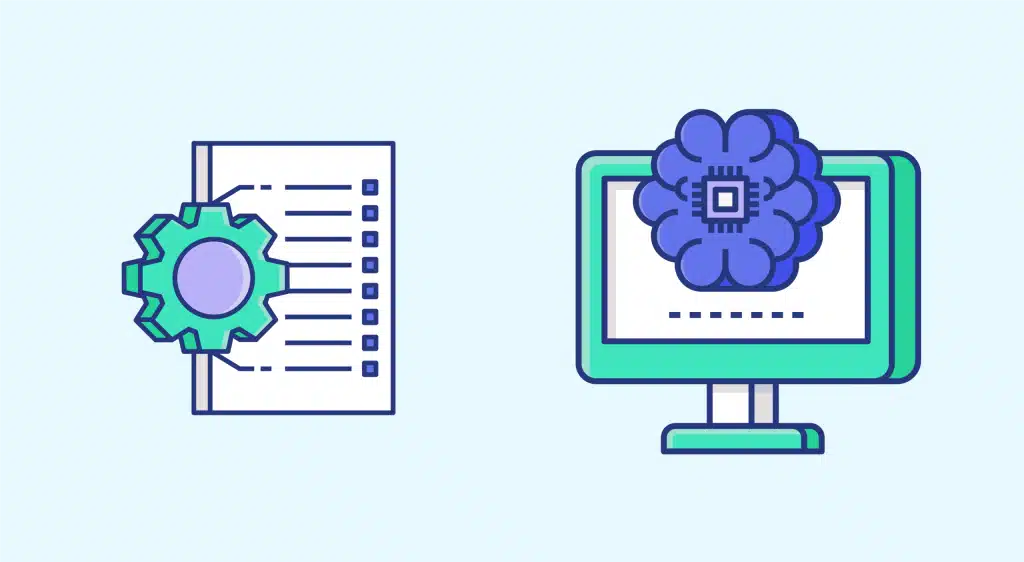The word algorithm is now part of everyday language. But what does it really mean? Behind this simple word lies a whole world of unsupervised learning, data science, neural networks... Why don't we take the time to define things? In this article, you'll discover or rediscover some useful Machine Learning algorithms to master.
☝️Let’s start with the basics: what’s the difference between machine learning and deep learning?
The major difference is the type of data. On the one hand, machine learning will process structured data (numerical data).
There’s also a difference between supervised and unsupervised algorithms.
In short, in the case of supervised learning, machine learning algorithms make predictions based on examples that have already been labeled. In unsupervised learning, on the other hand, predictions are made on a volume of unlabeled data. The machine learning model must therefore predict results without relying on predefined outcomes.
To find out more about unsupervised learning applications, read this article.
With that out of the way, we’re now going to talk about 3 of the main simple machine learning algorithms that are useful to master in business:
Logistic Regression
Logistic regression is used to study the relationships between qualitative variables Xi (features) and a qualitative variable Y. The logistic regression model provides the probability of an event occurring or not. To do this, we look for a link function h and optimize its regression coefficients. You can find out more about logistic regression here.
👉But what does it actually do?
Logistic regression is a basic machine learning algorithm, used to quickly classify data sets. In text detection, for example, logistic regression can be used to detect hate speech on a forum, or to classify the subjects of an article.
But logistic regression is also used in video games. Indeed, its strength lies in its simplicity, which means it can be implemented very quickly. Tencent, for example, uses it in its games to refine the recommendation system for in-game purchases.
And these fields are no exception: logistic regression can be found in medicine and industry alike. It’s an algorithm that needs to be mastered. Would you like to learn more about data science? We offer training courses to master all these algorithms.
KNN
The KNN method is a supervised learning method. The idea of this algorithm is to classify a point into categories based on the class of its nearest neighbors in the database. To find out more about the KNN algorithm, read our article on the subject.
This method is based on the adage: “Birds of a feather flock together”. Indeed, data of the same class are likely to be found close together. From a technical point of view, you need to choose the number of neighbors to study.
In practice, the KNN algorithm can be found in many applications due to its ease of implementation and simplicity. On the other hand, if the number of variables is large, it can quickly become too slow to be efficient.
This is particularly true of recommendation systems. Take, for example, a website that lets you choose your meal. To improve the recommendation, the site will take into account previous searches to provide new, similar results. It is therefore by using the nearest neighbor algorithm that the site is able to provide a result.
This machine learning algorithm is also used in real-time fraud detection. Here, we look for data that deviates from the norm, that doesn’t resemble classic patterns.
Admittedly, this algorithm is fast and simple, but it also needs to be fine-tuned. Indeed, this kind of classification can quickly exacerbate human bias. After all, such an algorithm reproduces existing patterns on a large scale. You need to take these biases into account to avoid generalizing them.
Decision trees
Decision trees are very popular Machine Learning models. They are very simple to interpret and quite reliable. This makes it possible to create decision-support tools for non-data teams.
This is based on decision trees, i.e. a series of multiple-choice questions leading to the final decision. The machine learning algorithm will iterate to define the probabilities of arriving at a decision. This optimizes the path to follow to reach the right result.
These decision trees can become very powerful when integrated into ensemblistic methods such as Random Forest.
However, care must be taken, as these algorithms can lead to overlearning. The algorithm will exacerbate perfect paths which, in the end, are only consistent with very specific situations.
So, we’ve quickly seen 3 of the main Machine Learning algorithms to master! These are useful in all fields, and can be applied to large databases as well as smaller structures. If you want to learn how to implement such algorithms, as well as bagging and boosting methods, our training courses will enable you to master the basic algorithms, as well as the more complex ones.










